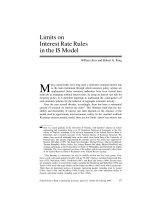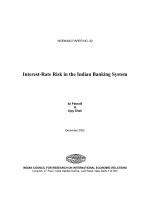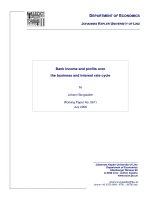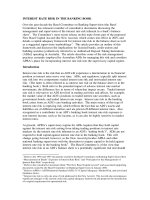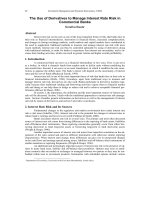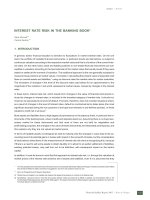Perfecting the mechanism for interest rate control in Vietnam today
Bạn đang xem bản rút gọn của tài liệu. Xem và tải ngay bản đầy đủ của tài liệu tại đây (235.22 KB, 8 trang )
ECONOMIC DEVELOPMENT
No. 207, November 2011
PERFECTING THE MECHANISM FOR
INTEREST RATE CONTROL IN VIETNAM TODAY
by MEcon. LE PHAN THANH HOỉA* & MEcon. LE PHAN THANH HIEP*
Interest rate is one of crucial tools for central banks to administer its monetary
policy, and has thus far been employed in many countries as an effective economic
tool. Particularly in the market economy, it has become a useful tool for the central
bank to control inflation and stimulate economic growth. Recently, Vietnams interest
rate has been a matter of concern to many researchers and the public. They were
wondering how the interest rate, in the context of high inflation rate, could attract
deposits and guarantee the payment ability of borrowers, appropriate costs as well as
acceptable profit for commercial banks.
The Vietnams State Bank Law 2010 has classified the interest rate as a tool for
administering monetary policy and preventing usury. The base rate, as prescribed in
the law, is based on market supply and demand and then promulgated by the SBV.
Additionally, the Vietnams State Bank Law 2010 also allows the SBV to manipulate
the mechanism for controlling the interest rate applied to transactions between
banking institutions and between them and customers in case of unusual fluctuations
in the money market.
In order to clarify the aforementioned objective of the SBV, the paper will analyze
and evaluate its interest rate controlling mechanism as from April 2010 till now, and
then recommend some measures to perfect the mechanism.
Keywords: interest rate, interest rate control, monetary policy, inflation, SBV
1. Deposit and lending rates
Following Resolution 23/2008/NQ-QH12 dated
Nov. 6, 2008 by the NA concerning the
socioeconomic development plan in 2009;
Resolutions 12/NQ-CP dated March 7, 2010 and
18/NQ-CP dated April 6, 2010 by the
Government; PM instructions in official letter
627/VPCP-KTTH dated Jan. 23, 2009 by the
Government Office regarding the application of
agreed-upon interest rate to banking institutions;
the SBV issued Circular 12/2010/TT-NHNN
24
RESEARCHES & DISCUSSIONS
dated April 14, 2010 permitting banking
institutions to lend in VND to customers at
agreed-upon interest rates. Accordingly, banking
institutions can set the lending rate based on the
SBV base rate and apply the agreed-upon
interest rate to loans supplied to highlyproductive projects according to rules set by
Banking Institutions Law, regulations about loan
supply, and signs from the market. In sum, the
lending rate of banking institutions is liberalized
in the hope of making the loan supply by
* Agribank Trửụứng Sụn
ECONOMIC DEVELOPMENT
No. 207, November 2011
commercial
banks
more
transparent,
constraining unfair competition, ensuring a real
value for interest rate, and lowering the interest
rate using competitive forces, thereby helping
customers get an easier access to bank loans.
money market. The open-market rate profoundly
influences the supply and demand of capital,
inter-bank rate, and deposit and lending rates of
commercial banks. The refunding rate and
overnight rate in the inter-bank electronic
Figure 1: Fluctuations in the borrowing rate and VND lending rate from April 2010 till now
From April 2010 until mid 2011, the deposit
rate and lending rate of banking institutions
have been on the same trend, and the difference
between these two rates is stably maintained at
around 2.8 to 4.0 percent per annum.
Nonetheless, in practice, such the difference is
slightly shortened due to the fact that most
banking institutions must pay for sale promotion,
marketing, and bonuses much more than
expected (i.e. expenses exceed the maximum
deposit rate ceiling whereas the lending rate
does not rise accordingly). Moreover, interest
payment from customers is not as high as
expected because economic recession prevented
customers from paying interest when due.
Although the interest rate goes up, the bank
deposit only rises slowly owing to impacts of
various factors, such as high inflation, increased
gold price, frozen real estate market, and
presence of suppliers of informal loans, etc.
Moreover, the SBV keeps manipulating
flexibly refunding rate, discount rate, and openmarket rate to regulate the interest rate on
payment system serves as rate ceilings in the
inter-bank market and are flexibly administered
in order to ensure the liquidity and enable
commercial banks to expand its credit effectively
to fields such as agriculture, rural areas, export,
and small and medium-sized enterprises. The
agreed-upon interest rate enhances the credit
quality through selecting effective business
projects, and enables banking institutions to
mobilize and lend capital.
The application of agreed-upon interest rate
will make activities in the finance market more
appropriate to the market mechanism. Sections
in the finance market are also enabled to link
together as per the theory of communicating
vessels, making them operate better and compete
in a fairer manner; and capital buyers in general
can benefit greatly in the medium and long term.
2. Refunding rate and rediscount rate
In order to finance commercial banks and play
well the role as the lender of last resort, the SBV
refund banks by financing valuable lending
RESEARCHES & DISCUSSIONS
25
ECONOMIC DEVELOPMENT
No. 207, November 2011
contracts signed by commercial banks. In
addition, discounting and rediscounting loans are
also included in the SBV refunding system.
Valuable papers accepted for SBV refunding
service include treasury bills and short-term loan
deeds, etc. Refunding and rediscount rates are
specifically stipulated according to the target of
the monetary policy. If inflation is too high, the
refunding and rediscount rates can be pushed up
to reduce the money supply and control the
inflation. During economic recession, they can go
down to stimulate economic growth.
In recent years, the interest rate has been
kept rather flexible as shown in the following
facts:
In the period 2000-2005, the macroeconomic
situation was stable; the refunding and
rediscount rates were respectively pegged at 6.5%
and 4.5% p.a. Yet, in the context of high inflation
and trade deficit in 2008, the refunding rate,
from 6.5% p.a., rose to 7.5%; 13%, and 15% p.a.;
the rediscount rate was also adjusted up to 6%,
11%, and 13% p.a. accordingly.
However, from September 2008 to September
2009, in order to constrain effects of the financial
crisis and global economic recession, and secure
the macroeconomic stability and social welfare,
the SBV did cut down all interest rates. That is,
the refunding rate, from 15% fell to 14%, 13%,
12%, 11%, 9.5%, 8%, and 7% p.a. respectively;
the rediscount rate, from 13% p.a., plunged to
12%, 11%, 10%, 9%, 7.5%, 6%, and 5% p.a. by the
end of 2009.
In 2010, to keep increases in monetary
indicators at reasonable levels in order to curb
inflation, support the economic growth, secure
the liquidity of banking institutions, help
banking institutions lower deposit and lending
rates, and simultaneously finance the rural and
agricultural development, SBV raised all rates:
The base rate rose from 8% to 9% p.a.; the
refunding rate was adjusted many time, inching
from 8% to 11%, 12%, 13% and 14% p.a.; and the
rediscount rate edged up 7%, 12% and 13% p.a.
accordingly.
26
RESEARCHES & DISCUSSIONS
Table 1: Fluctuations in SBV interest rates in
2010 – 2011 (% per year)
Date
Base
rate
Refunding
rate
Rediscount
rate
Jan. 1, 2010
8.00
8.00
6.00
Nov. 5, 2010
9.00
9.00
7.00
Feb. 17, 2011
9.00
11.00
7.00
March 8, 2011
9.00
12.00
12.00
April 1, 2011
9.00
13.00
12.00
May 1, 2011
9.00
14.00
13.00
Source: SBV
Refunding and rediscount rates have been two
fundamental components of the SBV refunding
policy over the past time. They help providing
capital for the market as well as the liquidity of
banking institutions. However, while SBV can
actively control the supply of capital, and it plays
a passive role in attracting capital from the
market.
Table 1 shows that the base rate was kept
stable, whereas the refunding rate and rediscount
rate skyrocketed. However, deposits at banking
institutions still rose slowly although they
continuously raised deposit rate, along with
bonuses, from 14% up to 18-19% p.a. By the end
of 2010, the bank deposit just increased by 24.5%
as compared to the same period of previous year.
By late May 2011, the bank deposit rose only 4%
and by the end of August 2011 around 8.44%
compared to late 2010.
Since September 2011, thanks to adjustments
to aforementioned interest rates and strict
control over maximum borrowing rate ceiling of
14% p.a. on banking institutions, the VND
deposit rate has been kept stable at 14% p.a. at
most, and lending rate has gradually fallen to
between 17 and 20 percent annually.
ECONOMIC DEVELOPMENT
No. 207, November 2011
3. Overnight rate
In 2002, SBV introduced a new banking tool,
the overnight rate, which was at first pegged at
10.8% p.a. In 2008 and 2009, this rate was
adjusted down. Yet in the following years, in
order to tighten monetary policies, it has been
raised many times to 8, 9, 11, 12, 13 and 14
percent per annum, respectively.
deposit rate, the SBV fixes the VND deposit rate,
including expenses on sale promotion of any
kind, at 14% p.a. at most (Circular 02/2011/TTNHNN dated March 3, 2011).
Additionally, the USD deposit rate in the
domestic market is much higher than the same
rates in the world market (i.e. SIBOR and
LIBOR) and in neighboring countries (Thailand,
Figure 2: Fluctuations in the overnight rate in the period 2005 – 2011
The overnight rate, which is mentioned above
and illustrated in Figure 2, is set by the state
bank. Nonetheless, the actual overnight rate
between commercial banks is always higher than
the SBV rate because banks often negotiate the
rate without rendering a report to SBV, and thus
SBV cannot control or keep a close watch on such
transactions. However, the overnight rate
illuminates the two phases of loosening and
tightening the monetary policy.
4. Reining in the VND and USD deposit rate
ceiling
In order to stabilize the money market, curb
inflation, and prevent commercial banks from
competing against one another by increasing the
Indonesia, Cambodia, Laos and China), and the
deposit rate paid by foreign banks to local banks.
Such a high USD deposit rate is not reasonable,
causing pressure on the rise in VND deposit rate
and USD lending rate. In order to keep the local
USD deposit rate in line with the foreign one
and stabilize the forex and money market as well
as attract foreign currencies to Vietnam, the SBV
has fixed the maximum USD deposit rate at 0.5%
p.a.
for
residence
and
non-residence
organizations
(not
including
banking
institutions), and 2.0% p.a. for all residence and
non-residence individuals (Circular 09/2011/TTNHNN dated April 9, 2011).
RESEARCHES & DISCUSSIONS
27
ECONOMIC DEVELOPMENT
No. 207, November 2011
5. Evaluating the SBV interest rate control
a. Achievements:
The SBV has controlled volatility in the
money market and risks of insolvency in
commercial
banks
(especially
small-sized
commercial banks developed from rural banks),
secured the safe operations of the banking
system, and strengthened the consumer
confidence in the banking system. Since June
2008 till now, the money market has step by step
been stabilized; and the deposit and lending
rates have been reasonably adjusted, meeting the
capital supply and demand in the local market
and
macroeconomic
factors.
Accordingly,
enterprises and households are enabled to access
bank loans, and the economic recession as a
result of the world financial crisis is also
weathered.
The transmission mechanism of SBV interest
rate policies is really effective and works well
with operations of commercial banks. This is
evident in the fact that the inter-bank rate only
varies between the refunding rate and the
rediscount rate; the deposit and lending rate of
commercial banks fluctuates according to changes
in supply and demand and ranges in line with
the SBV interest rates. SBV efforts have forced
commercial banks, especially those pursuing a
rapid growth in size, to adjust their targets and
mode of business by stringently controlling their
size and credit quality, and loans supplied to
investors in real estate and stock markets in
particular.
The base rate is not only a tool to regulate the
market but also a channel to broadcast the
government’s policy. SBV decisions to loosen or
tighten the monetary policy have become crucial
signals in the financial market. It has been
inspected, analyzed and predicted by the public,
enterprises, banking institutions, and local and
28
RESEARCHES & DISCUSSIONS
foreign investors who promptly reacted to any
changes in the base rate.
The foreign currency interest rate has been
basically liberalized, and the mechanism for
interest rates in domestic currency also follows
the same direction. Vietnam’s money market has
integrated closer to the regional and
international ones. Once the foreign currency
deposit rate goes up in foreign markets and
demand for bank loans in the domestic market
falls, banking institutions mobilize deposits in
foreign exchange and deposit them with foreign
banks, thereby increasing benefits for depositors,
the country and the institution itself. However,
once the interest rate plummets, deposits in
foreign banks will be withdrawn to invest in the
local market.
Banking institutions are freer, more dynamic
and flexible in deciding their lending and deposit
rates based on market fluctuations and effects of
SBV operations.
The circulation of capital in the economy and
among regions and industries is promoted by
attracting more deposits to the banking system
and investing more effectively for the sake of
customers. The interest rate really affects
decisions and relations (e.g. accumulation –
consumption, saving – investment, etc.) of
entities in the society.
In transactions between customers and
banking institutions, the fairness, equality, and
mutual consent on the deposit rate and lending
rate are always highly appreciated.
b. Some drawbacks:
The SBV has publicized various interest rates
(i.e. base rate, refunding rate, overnight rate, and
deposit rate for banking institutions in SBV) to
give signals and control interest rates in the
money market. Although the function of such
interest rates is different, they are partly
overlapped and cannot manipulate the market
rate which sometimes has the reverse effect to
ECONOMIC DEVELOPMENT
No. 207, November 2011
the official interest rates. In other words, official
rates are usually adjusted by market rates.
The relation between interest rates in the
money market and official ones by the state bank
is not close enough. The adjustment function of
refunding rates, rediscount, and open market has
been limited. The SBV has been forced to employ
various tools of the monetary policy, even
requesting commercial banks to constrain credit
growth and discussing the deposit rate ceiling, in
order to stabilize market rates.
The SBV faces some difficulties in
manipulating the market rate because the
market rate is affected by many factors that the
SBV cannot control such as the poor financial
resources of banking institutions, fluctuations in
the world market, and upheavals in supply of and
demand for capital, etc.
The inter-bank rate cannot precisely reflect
the relationship between supply and demand in
the capital market due to the fact that the
lending and borrowing is unidirectional from
state-run commercial banks as the lender with
abundant sources of capital to branches of foreign
banks and joint-stock banks.
Effects of the refunding rate on the monetary
policy are constrained because the government
restricts the annual supply of money used for
increasing bank credits when its main target is
to curb the inflation.
The transmission mechanism of official rates
is quite weak and tardy, thus effects on saving,
spending, investment, aggregate demand,
inflation control and economic growth are
limited. This is evident in various facts, such as
(1) interest rates in the money market is less
sensitive to official ones and so are prices of
financial asset; (2) the falling exchange rate is
kept within bands on either side of the official
rate and affected mainly by the supply of and
demand for foreign currencies rather than by
official interest rates; and (3) the expectation of
banking institutions and the public, although
affected by SBV adjustments to interest rates, is
quite poor.
Impacts of interest rate control mechanism
are weak, basically signaling “loosening” or
“tightening” direction, and cannot regulate the
inter-bank rate and the money market rate.
6. Causes for such drawbacks
a. Objective causes:
Vietnam is a small open economy with a poor
competitiveness, thus its finance-money market
is very vulnerable to volatility in the world
finance market (e.g. world financial crisis, and
fluctuations in the world market rate, etc.)
As prescribed in the Law on State Bank,
monetary policy and interest rate policy pursue
multiple goals which are not homogeneous. For
example, SBV has to increase interest rates and
reduce the money supply in order to curb
inflation, but this effort does not facilitate the
credit expansion for economic growth. Therefore,
selecting and manipulating a reasonable interest
rate
mechanism
become
very
difficult,
complicated, and less flexible.
Knowledge of the public and companies about
monetary policy and interest rate policy is still
limited while the interest rate controlling
mechanism is complicated, which made it
difficult to achieve the public agreement and
support for targets of the interest rate policy, and
sometimes might produce opposite effects.
The economy contains lots of potential risks
and inflation shows an onward trend, causing
interest rate to soar. Yet, monetary factors are
not its original excuse; and thus the SBV is
exposed to hardships in controlling the market
rate.
Dollarization is at a quite high rate (foreign
deposits/M2 = 16.7%) causing the market rate to
be affected not only by the supply-demand
relationship but also by the exchange rate. The
RESEARCHES & DISCUSSIONS
29
ECONOMIC DEVELOPMENT
No. 207, November 2011
world market rate and upheavals in the foreign
exchange market also sharply impinge on the
money market interest rate.
Due to the fact that there is also a great lag
time in administering tools of the monetary
policy (such as the required reserves, bands on
either side of exchange rate, and open market
operation, etc.), SBV cannot catch up with
practical fluctuations in interest rates and
disposable capital of commercial banks. Policy
tools are not sensitive to the money market, and
thus cannot have great effects, and the perfection
of agreed-upon interest rate mechanism is
hindered.
The world money market is disrupted and
contains numerous risks, and interest rates
widely fluctuate, adversely affecting the local
market
rate.
Moreover,
capital-related
transactions are gradually liberalized, causing
difficulties in controlling flows of capital and
regulating the market rate.
b. Subjective causes:
SBV has not operated proactively and
independently in administering the monetary
policy. Under the current mechanism, it is a
governmental agency that is directly controlled
by the government. Yet the government’s deep
intervention in the money market and banking
system will definitely reduce the independence
and dynamism of the SBV. Hence, SBV decisions
to administer the money market are not swift,
reducing the effectiveness of the monetary policy.
Collaboration between SBV and Ministry of
Finance in implementing the interest rate policy,
stabilizing the market rate and facilitating the
governance of monetary policies is poor. This is
evident in the fact that the interest rate of
treasury bills and bonds fiercely competes with
that of commercial banks, and thus the interest
rates cannot clearly reflect the relationship
between capital supply and demand.
30
RESEARCHES & DISCUSSIONS
SBV cannot accurately forecast fluctuations in
the supply and demand on the capital market as
well as the consumer price index, and thus the
planning of monetary policy and interest rate
policy is often disrupted.
The combination of the policy on exchange
rate and forex management with the interest
rate policy has not generated any mutual and
positive effects. Goals of those two policies have
no relation, and sometimes contradictory.
SBV has not been reasonably restructured
according to the request and restructuring
process of commercial banks. The restructuring of
SBV is to avoid overlap among departments and
enhance its effective operation. Accordingly, SBV
can observe the volume of disposable capital of
banking institutions and become more flexible in
employing open market operations and other
tools of the monetary policy to directly affect the
market rate.
7. Measures to perfect the SBV interest rate
controlling mechanism
Firstly, it is necessary to formulate an
interest rate controlling mechanism comprising
all SBV interest rates (i.e. rediscount rate,
refunding rate, open market operation rate, etc.)
to ensure that they are totally based on capital
supply and demand. Perfecting these interest
rates can help the money market operate more
frequently and effectively supporting open
market operation, inter-bank market, rediscount
loans, and refunding loans, etc.
Secondly, in order to enhance the
transmission power of the monetary policy, it is
crucial to develop the money market. Although
Vietnam’s money market has existed for years, it
has not well developed. The inter-bank market
for foreign and domestic currencies is the only
place for commercial banks to take out a loan.
Lending by SBV in the form of refunding, open
ECONOMIC DEVELOPMENT
No. 207, November 2011
market operation, foreign currency swap, and
sale and purchase of short-term valuable papers
aims at supplying short-term disposable capital
in VND to banks. The development of money
market is to make the aforementioned SBV
operations more flexible and perfect, enable all
banking institutions to take part in lending
channels and SBV credit activities, and
simultaneously guarantee smooth operations of
the inter-bank market.
Thirdly, SBV should immediately perfect the
agreed-upon interest rate regime and develop the
inter-bank market in which SBV must play well
its role as the lender of last resort. Additionally,
SBV needs to develop the forex market by
turning the foreign currency lending regime into
the foreign currency buying and selling practices,
and increase foreign exchange reserves through
the open market operation (i.e. SBV should
actively buy foreign currency when necessary).
Fourthly, SBV should quickly improve tools
of the monetary policy (e.g. open market
operation, refunding loans, rediscount loans,
required reserve ratio, and foreign currency swap,
etc.) which directly affect the interest rate;
actively, flexibly and punctually intervene in the
inter-bank market; and soon establish overnight
deposit service for banking institutions in the
SBV.
Fifthly, predicting macroeconomic matters in
general and fluctuations in the money market
and disposable capital of banking institutions in
particular must be improved. This is supposed to
be a vital part in planning and administering
short and long-term monetary policies effectively.
Econometric models can be employed to facilitate
the analysis, prediction and establishment of
monetary policies.
Sixthly, banking institutions need to strongly
control overheads and minimize direct and
indirect costs so as to reduce the lending rate for
the sake of customers.
Seventhly, SBV should examine components
of input costs and input interest rates of
commercial banks such as the required reserve
ratio, and the ratio of deposits from the treasury
for lending, etc. so as to reduce the lending rate
for the sake of customers.
Eighthly, SBV should be restructured so as to
avoid overlap in terms of function and duty of
each department, improve the competence of all
SBV departments, and modernize banking
technologies and facilities. It is also advised to
guarantee the independence of SBV in
administering the monetary policy, and assure
the close collaboration between SBV and
Ministry of Finance in controlling the interest
rate regime and monetary policy in generally.
In the context of a transition economy and
closer integration into the world economy, it is
really challenging to effectively administer the
interest rate regime, and achieve macroeconomic
targets. Thus, it requires a synchronous
combination with other tools of the monetary
policy
References
1. SBV (2010), Baùo caùo thöôøng nieân naêm 2010 (2010 Annual Report)
2. SBV press releases and other reports in 2010 and the first month of 2011, available at www.sbv.gov.vn
RESEARCHES & DISCUSSIONS
31

